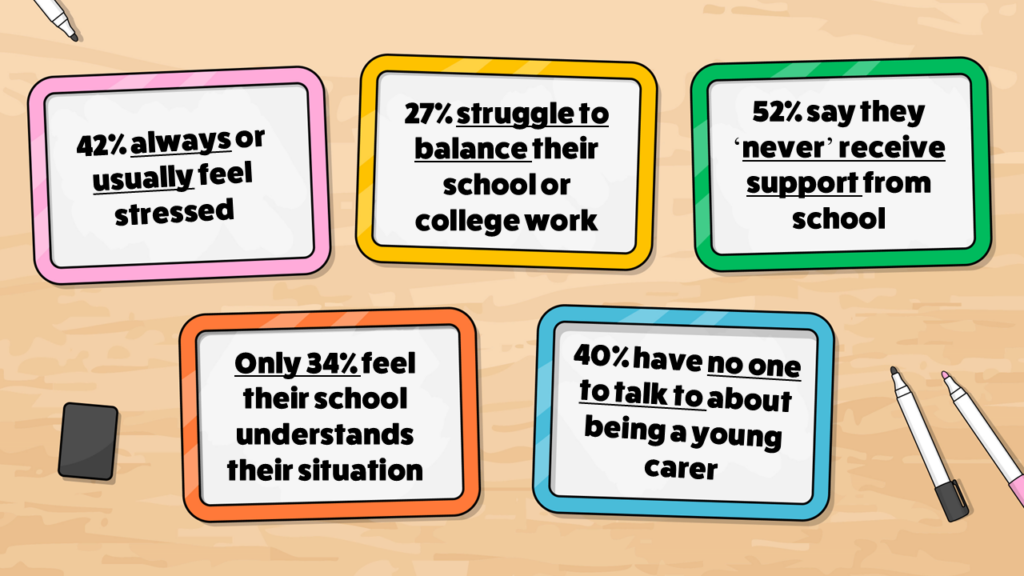Did you know that around one in five young people are young carers, with an estimated 800,000 young carers in England alone?
Young carers provide essential care for family members, and show remarkable resilience. However, their responsibilities at home can often impact their education, wellbeing, and future opportunities.
With the right strategies, schools can ensure these students feel understood and supported, without overloading already stretched staff and resources.
How Many Young Carers Are in the UK?
It is likely that every school in England has young carers, yet many remain unidentified. According to the 2021 Census, at least 120,000 young unpaid carers aged 5–17 exist in England, though some estimates suggest the real number could be as high as 800,000.
In Surrey alone, for example, there are an estimated 14,000 young carers.
Jill Coles, Children and Young People Team Manager from Action for Carers Surrey, told us that 72% of schools in the 2024 School Census reported having no young carers.
She tells me that young carers are a “hidden population,” and that many young carers “may not recognise that they’ve taken on a caring role, and concerns around being stigmatised or seen as ‘different’ from their peers may make young carers reluctant to self-identify.”
How Caring Responsibilities Affect Education
So, what is the reality for young carers when it comes to their education?
The numbers paint a worrying picture:

Statistics: Carers.org
Jill has found through her work that young carers “have to miss or cut short 48 school days per year.” With young carers in the UK having more time off school than their non-caregiving peers, this undoubtedly has an impact on their academic progress, confidence, and aspirations for the future.
And speaking of aspirations, it can be more difficult for young carers to achieve their full potential. Jill reports that “some young carers may leave school with the equivalent of 9 GCSE grades lower than their peers who have no caring role. Additionally, they’re overall at greater risk of becoming NEET (Not in Education, Employment, or Training).”
“Caring affects physical and mental health, for example, they can be tired in school if they have disrupted sleep from caring, they can spend time worrying about the person they care for, or the behaviours of the person they car for, making it difficult to focus in school.”
With this in mind, does this then mean that traditional approaches to teaching and learning aren’t properly supporting young carers?
Strategies for School to Support Young Carers
While schools are already under a lot of pressure, small and manageable changes can make a big difference to the lives of young carers.
Identifying young carers is essential to offering proper support in school, and Jill believes that “schools should work hard to reach this ‘hidden’ population.”
In collaboration with Action for Carers Surrey, we’ve outlined some practical strategies for schools to implement:

1. Identifying Young Carers Early
Many young carers do not recognise their role or may not want to disclose their situation due to stigma or fear of being treated differently. That’s why it’s important to use your professional judgement to identify young carers, but also to obtain information directly where possible.
- Ask relevant questions on school enrolment forms and record young carers on the School Census. Jill explains that “Young carer data needs to be collated as per SEN, Pupil Premium, and FSM data. It should be collated on the database, and all staff, including the admin team, need to be aware of this.”
- Train staff to recognise the signs of a young carer. We’ve outlined the signs in our free downloadable, which you can share with staff to help them support young carers.
- Create a culture of trust where students feel safe discussing their home responsibilities. Encourage open discussions about caregiving responsibilities in PSHE lessons, assemblies, or tutor time. Let students know that being a young carer is not a weakness or something to hide – it’s a role that deserves recognition and support.
- Use anonymous surveys or discussions in PSHE lessons to help identify hidden young carers. Many students won’t volunteer this information openly, but anonymous surveys or gentle class discussions about different home situations can help carers feel recognised without fear of stigma.
2. Flexible Learning Support
Young carers often struggle with deadlines and homework due to their unpredictable home responsibilities. Flexible adjustments can help them stay engaged without falling behind.
- Ensure flexible deadlines for homework and coursework, using your professional judgement. Jill explains that “it can be difficult for young carers to complete homework.” When caring responsibilities are affecting students’ ability to complete work, teachers should have the flexibility to offer alternative timelines without requiring a formal request.
- Provide access to catch-up sessions or homework clubs during school hours. After-school sessions may not be feasible for young carers, as they often need to be home for their family. Offering catch-up opportunities during lunchtimes or tutor periods gives them a chance to stay on track.
- Make use of technology (e.g. recorded lessons and online resources), so pupils can review materials at their own pace. For students who miss lessons due to caregiving duties, access to recorded content, class notes, or online resources can allow them to catch up when they have time.
3. A Named Staff Member for Support
Young carers need to know there’s someone in school who understands. Having a designated person available can help them feel supported without burdening all staff.
- Assign a Young Carers Champion. This could be a pastoral staff member, SENCO, or wellbeing officer. A single point of contact ensures that young carers don’t have to explain their situation repeatedly to different teachers. This role doesn’t have to be time-consuming – just someone trained to listen, advocate, and liaise with other staff.
- Provide drop-in support sessions where young carers can talk privately.
A weekly or fortnightly drop-in session (even just 20 minutes) can give young carers a safe space to share concerns and access support without needing to book a formal meeting.
4. Emotional Wellbeing & Peer Support
Caring responsibilities take a toll on mental health. Schools can provide low-effort, high-impact support by embedding wellbeing initiatives into existing systems.
- Set up peer support groups so young carers can connect with others facing similar challenges. Being a young carer can be isolating. A monthly group where they can meet peers who understand their challenges helps reduce loneliness and build resilience.
- Provide access to counselling or mentoring, helping them manage stress and emotions. Even occasional check-ins with a school counsellor, pastoral lead, or mentor can make a significant difference for a young carer feeling overwhelmed.
5. Strengthening Home-School Communication
A strong partnership with families ensures young carers receive the right support both at school and at home. However, many parents or guardians of young carers may not engage easily due to their own struggles.
- Develop relationships with parents/guardians to understand their home situation. Not all parents or guardians are aware of the impact caring has on their child’s education. A supportive, non-judgemental approach to family discussions can help schools find practical solutions together.
- Offer family support signposting for additional help outside of school. Families may be unaware of financial support, respite care, or external help available to them. Schools can signpost families to local services and help them access further assistance.

What Are the Next Steps for Schools?
- Review your current approach: Do young carers know who they can talk to? Is flexibility built into school policies?
- Raise awareness of young carers through assemblies and PSHE lessons. Young Carers Action Day on 12th March is a great opportunity to explore this in more detail with students.
- Provide CPD training: Ensure staff understand the needs of young carers and how to support them effectively. Organisations like Action for Carers offer regular free online training for staff.
- Signpost support: Ensure students and families know about local organisations that they can turn to for support, through lessons, assemblies, and home-school communication. Some organisations, such as Action for Carers, offer accreditation schemes to demonstrate whether a school is young-carer friendly.
Young carers give so much of themselves to others. With the right support, schools can ensure these students don’t have to sacrifice their education, wellbeing, or future in the process.
Download Our Free Young Carers Pack
To support your staff to identify young carers, we’ve created a free downloadable pack for you to use and share!
Supporting young carers starts with small, thoughtful adjustments that fit within existing pastoral care. Many schools are already doing fantastic work in this area, but with so many young carers still feeling unsupported, there is more to do.
What do you think needs to change when it comes to supporting young carers in schools? Join the discussion on LinkedIn.

